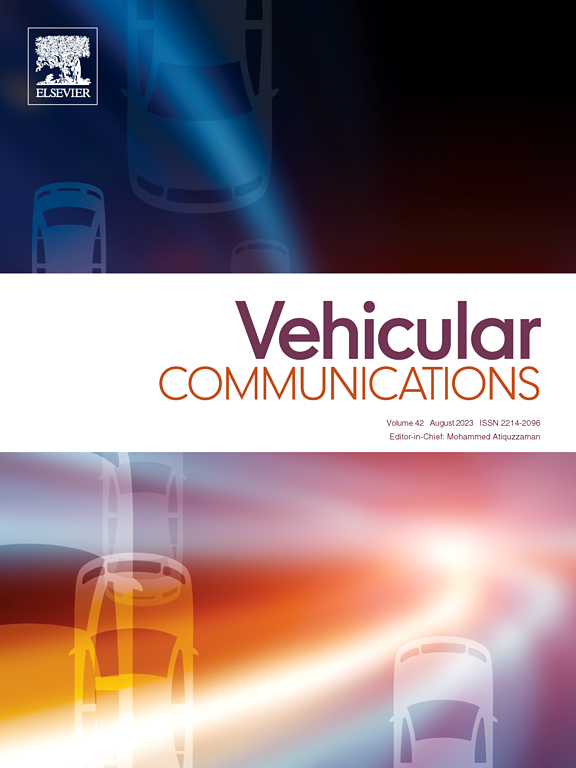Effective throughput maximization of beamspace MIMO-NOMA with finite blocklength
IF 6.5
2区 计算机科学
Q1 TELECOMMUNICATIONS
引用次数: 0
Abstract
Non-orthogonal multiple access (NOMA) has recently been integrated into beamspace multiple-input multiple-output (MIMO) for improved capacity and throughput. To apply the promising beamspace MIMO-NOMA in practical millimeter-wave applications, finite blocklength has to be considered. Therefore, in this article, we consider the effective throughput as the performance metric, which incorporates both the transmission rate and error performance in the finite blocklength regime. For the considered downlink beamspace MIMO-NOMA system, we derive the expression of system effective throughput with given blocklength and decoding error probability. To maximize the system effective throughput and simultaneously provide the quality-of-service (QoS) guarantee of data rate for each user, the transmit precoding and power allocation are optimized. We first provide an effective precoding design to mitigate the inter-beam interference. For power allocation, we apply monotonic optimization to obtain a globally optimal solution, and further develop a low-complexity algorithm based on the principles of convex-concave procedure (CCP). Simulation results show that the proposed schemes achieve higher spectrum and energy efficiency compared to several baseline schemes, including the traditional resource allocation algorithm based on the infinite blocklength assumption, and the existing beamspace MIMO.
有限块长波束空间MIMO-NOMA的有效吞吐量最大化
非正交多址(NOMA)最近被集成到波束空间多输入多输出(MIMO)中,以提高容量和吞吐量。为了将有前途的波束空间MIMO-NOMA应用于实际的毫米波应用,必须考虑有限的块长。因此,在本文中,我们考虑有效吞吐量作为性能指标,它结合了有限块长度制度下的传输速率和错误性能。对于考虑下行波束空间的MIMO-NOMA系统,导出了给定分组长度和译码错误概率下系统有效吞吐量的表达式。为了最大限度地提高系统的有效吞吐量,同时为每个用户提供数据速率的QoS (quality-of-service)保证,优化了发送预编码和功率分配。我们首先提供了一种有效的预编码设计来减轻波束间干扰。在功率分配问题上,我们采用单调优化方法得到全局最优解,并进一步发展了一种基于凸凹过程(CCP)原理的低复杂度算法。仿真结果表明,与基于无限块长假设的传统资源分配算法和现有波束空间MIMO等基准方案相比,所提方案具有更高的频谱效率和能量效率。
本文章由计算机程序翻译,如有差异,请以英文原文为准。
求助全文
约1分钟内获得全文
求助全文
来源期刊

Vehicular Communications
Engineering-Electrical and Electronic Engineering
CiteScore
12.70
自引率
10.40%
发文量
88
审稿时长
62 days
期刊介绍:
Vehicular communications is a growing area of communications between vehicles and including roadside communication infrastructure. Advances in wireless communications are making possible sharing of information through real time communications between vehicles and infrastructure. This has led to applications to increase safety of vehicles and communication between passengers and the Internet. Standardization efforts on vehicular communication are also underway to make vehicular transportation safer, greener and easier.
The aim of the journal is to publish high quality peer–reviewed papers in the area of vehicular communications. The scope encompasses all types of communications involving vehicles, including vehicle–to–vehicle and vehicle–to–infrastructure. The scope includes (but not limited to) the following topics related to vehicular communications:
Vehicle to vehicle and vehicle to infrastructure communications
Channel modelling, modulating and coding
Congestion Control and scalability issues
Protocol design, testing and verification
Routing in vehicular networks
Security issues and countermeasures
Deployment and field testing
Reducing energy consumption and enhancing safety of vehicles
Wireless in–car networks
Data collection and dissemination methods
Mobility and handover issues
Safety and driver assistance applications
UAV
Underwater communications
Autonomous cooperative driving
Social networks
Internet of vehicles
Standardization of protocols.
 求助内容:
求助内容: 应助结果提醒方式:
应助结果提醒方式:


